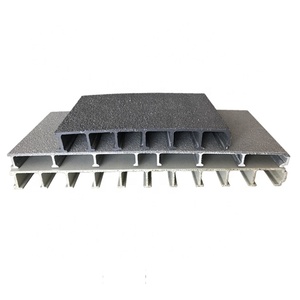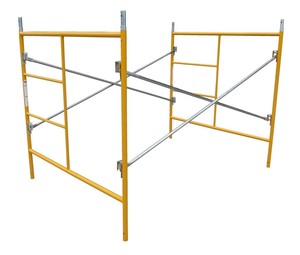(1413 products available)








































































































































































































Composite scaffolding is made from reinforced plastic and is used for various purposes. It is considered an excellent alternative to traditional scaffolding due to its strength, durability, and low maintenance. Here are the types of composite scaffolding:
This type of composite scaffolding is made from fiberglass, which is a reinforced plastic material. It is mostly used for construction projects because it is very strong, lightweight, and easy to install. The scaffolding is made up of planks, frames, and guardrails that can be put together easily. They can be assembled and taken apart quickly, making it a great choice for projects that need to move scaffolding around.
Fiberglass-reinforced plastic (FRP) scaffolding is also popular for electrical and telecommunication projects. It is non-conductive, meaning it doesn't conduct electricity, which makes it safe to use around power lines and electrical equipment. TFR scaffolding is available in different designs, including single and double width, and can be adjusted to different heights.
Carbon fiber-reinforced plastic (CFRP) scaffolding is made from carbon fiber and is more robust than TFR but is also more expensive. It is commonly used in the aviation and aerospace industry, and any other industry that needs lightweight but very strong scaffolding, such as Formula 1 racing. CFRP scaffolding is also popular in the military because it is lightweight, durable, and can be set up quickly.
There is also glass fiber-reinforced plastic (GFRP) scaffolding, which is used for support beams and structural components. The aluminum support beams are usually covered with GFRP to provide extra support and reinforcement for construction workers and materials. The glass fiber-reinforced scaffolding is non-corrosive and non-conductive, which makes it safe and long-lasting.
WPC scaffolding is made from wood particles and plastic resin and is used in construction, decoration, and advertising. It is used to build platforms, floors, and steps and is very durable and weather-resistant. WPC scaffolding also has an anti-slip surface, making it safe for workers to use in wet and slippery conditions.
The functions of composite scaffolding are to provide a structure that can be used for support. Some of the features are safety, durability and versatility.
Composite scaffold boards are a temporary framework that consists of prefabricated components. It is used in several industries, including construction, oil and gas, shipbuilding, and manufacturing. These industries use the composite scaffolding to:
Composite scaffolding has several features that make it ideal for the functions mentioned above. Some of the important features of composite scaffolding are:
Composite scaffolding is widely used in the construction industry. This is because it provides a safe and stable platform for workers to work at different heights. These include tasks such as painting, plastering, and bricklaying. Additionally, construction companies prefer composite scaffolding because it is lightweight. As a result, workers can easily move and assemble it on-site.
Composite scaffolding is commonly used for building maintenance. It enables workers to access different parts of a building for cleaning, repairs, and inspections. It is also preferred for building maintenance because it is easy to set up and dismantle. This is essential for property owners who need to carry out regular maintenance tasks.
Event planners use composite scaffolding to set up stages and lighting for concerts, festivals, and other outdoor events. The strong and durable platform can support equipment and performers. Additionally, it offers a stable platform for workers to install sound systems, lighting, and other event equipment.
Composite scaffolding is used in shipbuilding yards and offshore construction. The material is resistant to corrosion, making it ideal for marine environments. Workers use it to build, maintain, and repair ships and offshore structures. It also provides a safe working platform for tasks such as welding, painting, and assembly.
Telecommunication and power line companies use composite scaffolding for installing and maintaining cables, wires, and antennas. The scaffolding is electrically non-conductive, making it safe to use around power lines.
Engineers and construction workers use composite scaffolding to access and work on bridges, tunnels, and elevated highways. The scaffolding provides a stable and safe platform for tasks such as welding, painting, and concrete repair.
In emergency situations, such as building collapses, earthquakes, or fires, first responders and rescue teams use composite scaffolding to access and rescue victims. The scaffolding provides a safe and stable platform for rescue operations in challenging environments.
It is important to ensure that the composite scaffold boards for sale can support the weight of both the workers and the construction materials. The load capacity should be such that it can safely accommodate workers and tools. Check the maximum load the scaffolding can handle without the risk of collapsing.
Each construction project will require a different platform height, so get composite scaffolding that can be adjusted to fit the needs of different projects. This will save the company money as opposed to buying different sets for each project. Adjustable scaffolding allows workers to complete various types of projects at different heights with the same equipment.
Composite scaffolding is meant to be moved around the worksite. It is important to get lightweight but sturdy options so they can be easily transported. Look for easy-to-carry designs and those with wheels for easy movement.
The quality of the composite material used in the scaffolding will determine its strength and durability. Look for high-quality materials that will not degrade quickly. This is important because the scaffolding will be exposed to different elements and used in various projects.
Ensure the platform is wide enough to accommodate workers and their tools. A wider platform allows for better movement and is safer than a narrow one. A spacious platform reduces congestion and the risk of accidents.
Look for features that increase the stability of the composite scaffolding. Anti-slip surfaces will prevent workers from falling on wet or greasy platforms. Adjustable legs can also help the scaffold remain stable on uneven ground.
Choose composite scaffolding that can be easily collapsed for storage. Collapsible options will save storage space and make it easy to transport them when not in use. They can be assembled and disassembled quickly, saving time during the construction process.
Ensure the composite scaffolding meets industry standards for safety and quality. This will ensure the scaffolding is safe to use so that workers can do their job without worrying about accidents.
While it is important to get high-quality scaffolding, also ensure it is within the company's budget. Compare different options to find a composite scaffolding that offers good value for money.
Q1: Can a composite scaffolding be used for multiple projects?
A1: Yes, composite scaffolding can be used in multiple projects. This is because it is durable and versatile. It is designed to withstand harsh weather conditions, making it usable in various outdoor and indoor applications.
Q2: What are the safety measures for composite scaffolding?
A2: To ensure safety, ensure the ground is level and stable before erecting the scaffolding. Also, follow the manufacturer's guidelines when setting up and dismantling the scaffolding. When using the scaffolding, ensure workers wear protective gear to prevent falls and injuries.
Q3: Can one customize the composite scaffolding?
A3: Yes, one can customize the composite scaffolding. Buyers can specify the sizes and designs they want for the scaffolding. Some manufacturers allow buyers to add their brand logo and name to the scaffolding.